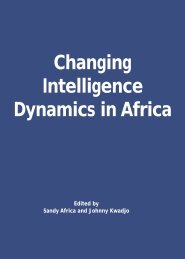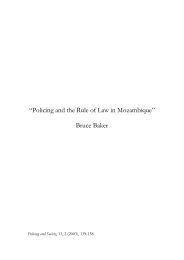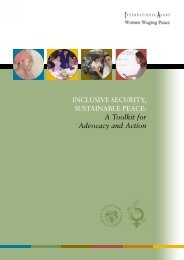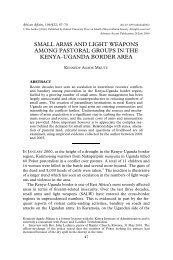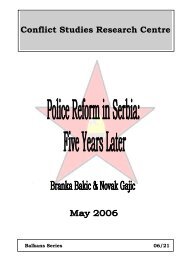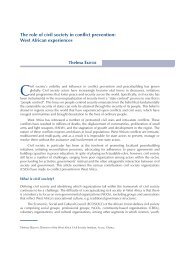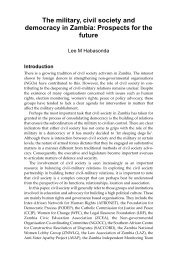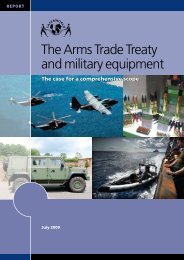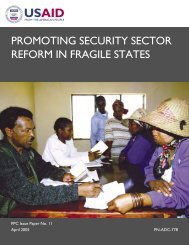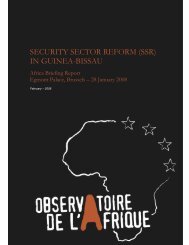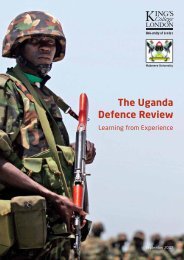AFGHANISTAN'S ELECTION CHALLENGES
AFGHANISTAN'S ELECTION CHALLENGES
AFGHANISTAN'S ELECTION CHALLENGES
You also want an ePaper? Increase the reach of your titles
YUMPU automatically turns print PDFs into web optimized ePapers that Google loves.
Afghanistan’s Election Challenges<br />
Crisis Group Asia Report N°171, 24 June 2009 Page 7<br />
III. 2ELECTORAL FRAMEWORK<br />
The constitution provides basic direction on “free,<br />
general, secret and direct” polls, which are to be conducted<br />
by the Independent Election Commission<br />
(IEC). 44 The president 45 stands for a five-year term on<br />
a slate with two vice presidents and must receive more<br />
than 50 per cent of the votes cast nationwide – with a<br />
run-off between the top two candidates if necessary. 46<br />
There is a maximum two-term limit. 47 The Wolesi<br />
Jirga is elected for five years with representatives<br />
“proportionate to the population of each constituency” 48<br />
while provincial councils are chosen every four years,<br />
“proportionate to the population”. 49 Used in 2005, the<br />
controversial Single Non-Transferable Vote (SNTV)<br />
remains the electoral system for the Wolesi Jirga and<br />
provincial council elections. A province forms a single<br />
constituency with multiple representatives (around a<br />
quarter of seats reserved for women in both bodies<br />
through a top-up system), 50 all standing as individuals<br />
and with each voter given only one choice. 51 District<br />
councils, which have not been elected to date, have a<br />
three-year term with little constitutional direction on<br />
implementation. 52<br />
Broadly accepted electoral institutions and a comprehensive<br />
legal framework are essential for electoral<br />
credibility. Disappointingly little has been achieved<br />
since the last election in Afghanistan, although most<br />
technical and logistical problems were long foreseen<br />
44 Article 156 of the constitution: “The Independent Election<br />
Commission shall be established to administer and<br />
supervise every kind of elections as well as refer to general<br />
public opinion of the people in accordance with the provisions<br />
of the law”.<br />
45 Article 60 of the constitution: “The President shall be the<br />
head of the state of the Islamic Republic of Afghanistan,<br />
executing his authorities in the executive, legislative and<br />
judicial fields in accordance with the provisions of this<br />
Constitution”.<br />
46 Articles 60 and 61 of the constitution.<br />
47 Article 62 of the constitution.<br />
48 Article 83 of the constitution.<br />
49 Article 138 of the constitution.<br />
50 Articles 22 and 29 of the Electoral Law (2005).<br />
51 For more on how SNTV came to be chosen in Afghanistan<br />
(previously used in Japan and currently only found in Vanuatu,<br />
Jordan and the Pitcairn Islands), see Andrew Reynolds,<br />
“The Curious Case of Afghanistan”, Journal of Democracy,<br />
vol. 17, no. 2 (April 2006).<br />
52 Article 140 of the constitution. “Councils shall be established<br />
to organise activities as well as attain active participation<br />
of the people in provincial administrations in districts<br />
and in villages”. Mayors and municipal councils are also<br />
supposed to be elected although no term limit is set. Article<br />
141 of the constitution.<br />
and meaningful reform recommended. The 2005 Post-<br />
Election Strategy Group put forward a number of<br />
reforms, including the retention of IEC staff, a more<br />
realistic electoral timetable and better legal framework,<br />
and such basic suggestions as buying a large government<br />
printing press rather than repeatedly printing<br />
ballots at enormous expense abroad. 53 A 2006 UNDP<br />
post-election assessment similarly emphasised the need<br />
for foresight and sustainable planning if elections were<br />
to be part of a wider democratisation process rather<br />
than individual, and expensive, events. 54 The lack of<br />
UN, donor and Afghan attention to electoral reform,<br />
particularly in 2006-2007 when there was sufficient<br />
time to ensure implementation, lies at the heart of<br />
many of the difficulties Afghanistan faces today. Even<br />
relatively simple technical issues have become highly<br />
politicised contests.<br />
A. 9LEGAL FRAMEWORK<br />
All laws enacted as presidential decrees before the<br />
2005 inauguration of the National Assembly have<br />
been submitted to the legislature but remain in force<br />
unless specifically annulled. 55 Given the hundreds of<br />
backed-up decrees and a new assembly that lacks the<br />
organising power of political parties, legislation is a<br />
slow process. 56 Tight constitutional timelines for laws<br />
to move through the bicameral legislature and receive<br />
presidential assent have been routinely ignored 57 in<br />
what is often a chaotic process with amendments introduced<br />
right until the last minute. When the president<br />
has been thwarted – the Wolesi Jirga having the<br />
power to override his veto with a two-thirds majority<br />
58 – he has tended to deem such laws unconstitutional<br />
and directed them to the Supreme Court or<br />
simply left them in limbo.<br />
53 “Post-Election Strategy Group Progress Report”, op. cit.<br />
54 “Afghanistan Voter Registration 2003 and Elections Projects<br />
2004/2005”, op. cit.<br />
55 Article 161 of the constitution.<br />
56 Recent streamlining of internal legislative processes has<br />
somewhat improved things.<br />
57 Article 97 of the constitution: “The House of the People<br />
shall not delay more than one month the draft proposal.<br />
The House of the People after approving the proposed draft<br />
shall send it to the House of the Elders. The House of the<br />
Elders shall decide on it within 15 days”.<br />
58 Article 94 of the constitution: “in case the President rejects<br />
what the National Assembly has approved, the President<br />
shall send it back, within 15 days from the date it was<br />
presented to the House of the People mentioning the reasons<br />
for rejection and with expiration of the period or if the<br />
House of the People re-approves it with two-thirds of all<br />
the votes, the draft shall be considered endorsed and enforceable”.



